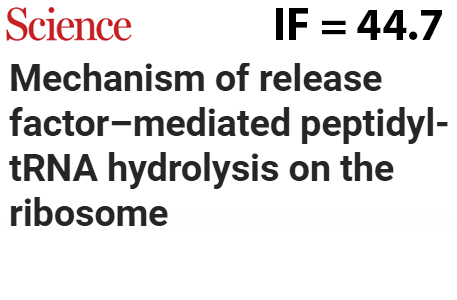
Раскрыт механизм терминации трансляции
Биосинтез белка рибосомой — важнейшая реакция в живой природе. Длина полипептидной цепи строго определена стартовым и стоп-кодонами в мРНК. Терминация трансляции необходима для своевременного окончания биосинтеза белка и высвобождения готового полипептеда из рибосомы. Этот процесс регулируется специальными белками, т.н. «релиз-факторами», которые распознают стоп-кодоны и опосредуют гидролиз сложноэфирной связи в молекуле пептидил- тРНК, находящейся в каталитическом центре рибосомы. В новом исследовании показана роль релиз-фактора и 2'-OH группы тРНК в катализе обрыва цепи через образование «мостикового» циклического интермедиата. Работа опубликована в журнале Science. Подробнее
Новости 
- Об участии в десятом Форуме молодых ученых стран БРИКС
конференции
3.VII В рамках преемственности реализации инициатив научно- технологического трека БРИКС Департамент международного сотрудничества Министерства науки и высшего образования Российской Федерации информирует о проведении конкурсного отбора на участие в десятом Форуме молодых ученых стран БРИКС, а также во восьмом Конкурсе молодых инноваторов стран БРИКС. В 2025 году Форум пройдет с 15 по 17 сентября в г. Бразилиа (Федеративная Республика Бразилия) в очном формате. Рабочий язык мероприятия – английский. Подробности в Приложении
- Конференция для молодых ученых «Генетические технологии в биомедицине» и Школа для молодых ученых «Транскриптом в пространстве и времени: новые подходы к изучению объектов биологии развития» 25-27.09.2025
конференции
30.VI Глубокоуважаемые коллеги! В Институте биологии развития им. Н.К. Кольцова РАН, 25 сентября 2025 года пройдет Международная конференция для молодых ученых «Генетические технологии в биомедицине» при поддержке Министерства науки и высшего образования РФ (в соответствии с Соглашением с Министерством науки и высшего образования РФ № 075-15-2025-464 от 29.05.2025 г), а 26-27 сентября 2025 года будет проведена Школа для молодых ученых «Транскриптом в пространстве и времени: новые подходы к изучению объектов биологии развития» при поддержке Российского научного фонда (грант № 21-74-30015-П). Направляем Вам первое информационное письмо. Подробная информация о Конференции и Школе размещена на соответствующих страницах в левом меню сайта ИБР РАН.
- Раскрыт механизм терминации трансляции
наука
27.VI Биосинтез белка рибосомой — важнейшая реакция в живой природе. Длина полипептидной цепи строго определена стартовым и стоп-кодонами в мРНК. Терминация трансляции необходима для своевременного окончания биосинтеза белка и высвобождения готового полипептеда из рибосомы. Этот процесс регулируется специальными белками, т.н. «релиз-факторами», которые распознают стоп-кодоны и опосредуют гидролиз сложноэфирной связи в молекуле пептидил- тРНК, находящейся в каталитическом центре рибосомы. В новом исследовании показана роль релиз-фактора и 2'-OH группы тРНК в катализе обрыва цепи через образование «мостикового» циклического интермедиата. Работа опубликована в журнале Science.
События 
- VII Всероссийская конференция "Фундаментальная гликобиология"
наука
22–26.IX Уважаемые коллеги! Приглашаем вас принять участие в работе VII Всероссийской конференции «Фундаментальная гликобиология», которая пройдет 22-26 сентября 2025 г. в Москве на базе ГНЦ ИБХ РАН.
- XXXVIII международная зимняя молодежная научная школа «Перспективные направления физико-химической биологии и биотехнологии»
наука
9–11.II.26 Учебно-научный центр Государственного научного центра Института биоорганической химии им. академиков М.М.Шемякина и Ю.А.Овчинникова Российской академии наук (далее - ГНЦ ИБХ РАН) приглашает школьников старших классов, студентов, аспирантов и молодых ученых в возрасте до 35 лет, проводящих научные исследования в области биоорганической химии, молекулярной биологии, биохимии, биотехнологии и биомедицины, принять участие в работе XXXVIII международной зимней молодёжной научной школы "Перспективные направления физико-химической биологии и биотехнологии" (далее – Школа-2026). Школа-2026 будет проведена в ГНЦ ИБХ РАН с 9 по 11 февраля 2026 года.
- Заседание Диссертационного совета ГНЦ ИБХ РАН
диссертационный совет
25.VI (Событие окончено) 25 июня, в среду, сразу после заседания Учёного совета, в Большом зале БОНа состоится заседание Диссертационного совета. ПОВЕСТКА: Принятие к защите поступивших в диссертационный совет докторских и кандидатских диссертаций.












